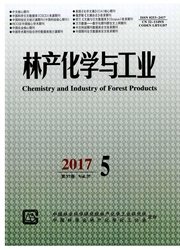

 中文摘要:
中文摘要:
为探讨解结晶处理提高酶水解效率的机理,对比研究了高结晶度的微晶纤维素(MCC)和低结晶度的解结晶微晶纤维素(D-MCC)对纤维素酶的吸附过程。结果发现:酶吸附平衡后,样品的XPS和FT-IR分析表明纤维素酶通过酶蛋白的氨基(—NH2)与纤维素分子链上的羟基(—OH)之间以氢键(C—OH…NH)力吸附在MCC上;相同条件下得到的MCC和D-MCC吸附率曲线的差异表明,底物结构的改善比提高温度更能提高酶吸附率;比较纤维素酶对MCC和D-MCC在35℃下的吸附动力学可知,通过降低底物的结晶度可促进酶吸附,刚性结构的MCC更满足准一级动力学的假设,D-MCC表面结构相对松散,其吸附过程需进一步分析,以得到更适合的动力学方程。
 英文摘要:
英文摘要:
The cellulase adsorbed and formed enzyme-substrate( ES) compound is a key step in the process of enzymatic hydrolysis. Through the comparison of cellulase adsorbed on two substrates: microcrystalline cellulose( MCC) with high degree of crystallinity and decrystallization microcrystalline cellulose( D-MCC) with low degree of crystallinity,it was found that,in the XPS wide scan patterns of adsorption equilibrium MCC,a new absorption peak of nitrogen element( 399. 06 e V) was observed. The fitting method is adopted to treat the strong peak of XPS-O1 s,and the binding energy of this new peak was only 530. 53 e V. In the infrared absorption range of 3050- 3550 cm- 1,the absorption intensity of OH group decreased with extending adsorption time on cellulose. The above results proved that new hydrogen bonds( C—OH…NH) between the protein amino( —NH2) and cellulose molecule chain( —OH) were generated during the cellulose adsorption process. From the comparison of the adsorption rate curves between MCC and D-MCC,the decrystallization method to improve cellulase adsorption was more effective than enhancing the temperature. From the comparison of adsorption kinetics between MCC and D-MCC at 35℃,it was indicated that a reduction of cellulose crystallinity was positive for adsorption rate. MCC with rigid surface was fit for the first-order kinetic hypothesis. D-MCC with flexible surface was not suitable for the first-order kinetic. A more suitable kinetic hypothesis should be investigated in the future.
 同期刊论文项目
同期刊论文项目
 同项目期刊论文
同项目期刊论文
 Hydrogenation of Ethyl Acetate to Ethanol over Ni-Based Catalysts Obtained from Ni/Al Hydrotalcite-L
Hydrogenation of Ethyl Acetate to Ethanol over Ni-Based Catalysts Obtained from Ni/Al Hydrotalcite-L Poplar Woodchip as a Biorefinery Feedstock-Prehydrolysis with Formic/Acetic Acid/Water System, Xylit
Poplar Woodchip as a Biorefinery Feedstock-Prehydrolysis with Formic/Acetic Acid/Water System, Xylit Enhancing the enzymatic hydrolysis of corn stover by an integrated wet-milling and alkali pretreatme
Enhancing the enzymatic hydrolysis of corn stover by an integrated wet-milling and alkali pretreatme Wet Aerobic Oxidation of Lignin into Aromatic Aldehydes Catalysed by a Perovskite-type Oxide: LaFe1-
Wet Aerobic Oxidation of Lignin into Aromatic Aldehydes Catalysed by a Perovskite-type Oxide: LaFe1- Hydrolysis of wheat straw hemicellulose and detoxification of the hydrolysate for xylitol production
Hydrolysis of wheat straw hemicellulose and detoxification of the hydrolysate for xylitol production Preparation of xylose and kraft pulp from poplar based on formic/acetic acid/wheat system hydrolysis
Preparation of xylose and kraft pulp from poplar based on formic/acetic acid/wheat system hydrolysis Changes of the surface structure of corn stalk in the cooking process with active oxygen and MgO-bas
Changes of the surface structure of corn stalk in the cooking process with active oxygen and MgO-bas Efficient conversion of D-glucose into D-sorbitol over MCM-41 supported Ru catalyst prepared by a fo
Efficient conversion of D-glucose into D-sorbitol over MCM-41 supported Ru catalyst prepared by a fo Perovskite-type Oxide LaMnO3: An Efficient and Recyclable Heterogeneous Catalyst for the Wet Aerobic
Perovskite-type Oxide LaMnO3: An Efficient and Recyclable Heterogeneous Catalyst for the Wet Aerobic Silicalite filled polyether-block-amide membranes for recovering ethanol from aqueous solution by pe
Silicalite filled polyether-block-amide membranes for recovering ethanol from aqueous solution by pe 期刊信息
期刊信息
